Ken Pearson’s reminiscences
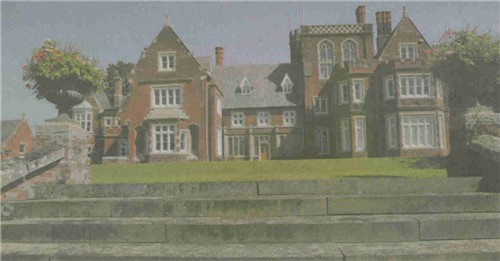
Frogmore Hall after refurbishment
You may have read in the recent press (November 2007) that Frogmore Hall, described as “a stunning Grade II listed building overlooking the Beane Valley near Watton-at-Stone was being brought to the market. The building has been sympathetically refurbished and now comprises six generously designed apartments in the main house, three homes created from the coach house and one newly built family home”.
The original house was constructed in 1863 from red brick and comprised a 60 room mansion and adjoining stable block. Originally the residence of G. B. Hudson, MP for the Hitchin Division of Hertfordshire it was taken over by the Government during the Second World War when it became Station 18, an outstation of Station 43 at Audley End House, headquarters of the Special Operations Executive (SOE) Polish Section. Frogmore Hall acted as a holding and dispatch station for agents being parachuted into Poland until the end of the war.
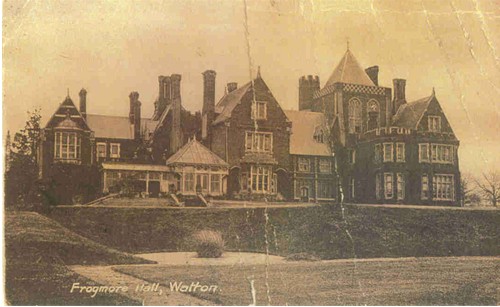
Frogmore Hall from an early postcard
STL was the first of a series of commercial companies to occupy the mansion being followed by the housing development company Fairview Estates and the ill fated Jarvis company of Railtrack fame.
In September 1988 Ken Pearson wrote the following reminiscences of Frogmore.
During the late 1950’s the natural expansion of STL meant that the buildings in Progress Way were just too small. As a result a few particles were expelled into convenient (or sadly inconvenient) locations, usually in Enfield. However, for some reason, the Systems Planning Division was exiled to an old house, called The Thrifts, on the outskirts of Ware. At that time the Radio Planning Department of that Division was much involved in carrying out radio surveys of potential microwave routes for customers, and as their work grew it became increasingly difficult to store all the necessary equipment. Moreover, there was no open space where masts could be erected for training or experiment.
Then, in 1956, Arthur Brown found a place called Frogmore Hall, which had a large house, lots of land, with virtually no planning restrictions, and the Radio Survey Section was formed and installed in Frogmore Hall.
Also at that time a new site for STL was being sought, and Arthur Brown was actively exploring several possibilities. The writer accompanied him on some of his expeditions to see whether the proposed site would be suitable for our radio survey and experimental work. As it happened, we found a suitable site, from most points of view, at Cheshunt but the local residents, led by a Harley Street specialist and his wife, objected that having a laboratory in the area would greatly lower the tone of the neighbourhood and the matter went to a Planning Enquiry where STL lost the day. Then the site at Harlow, on the STC playing fields, was offered and was accepted. Unfortunately, it transpired that Harlow Development Corporation allowed us to enter their hallowed fields only because STL were “non-industrial”, so we could not, at that time, put up any masts or huts. Looking round today one feels that the rules must have been relaxed!
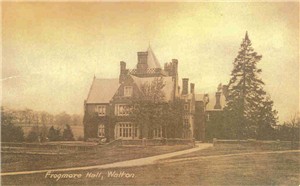 So Frogmore Hall was obviously still very useful to STL. The hall is an old Victorian mansion set in some 50 acres near Watton-at-Stone, a village on the Hertford to Stevenage road. It is a very ugly house as the photographs show, but it had plenty of room and, of course, the surrounding fields. It was owned by a sand and gravel company and, at that time, was being used by a local farmer for storage. The site’s suitability for line-of-sight microwave experiments was assessed, but the only direction which provided a clear path more than a mile or so long was towards Marconi at Writtle! Nevertheless it was decided that Frogmore Hall would be a very useful site.
So Frogmore Hall was obviously still very useful to STL. The hall is an old Victorian mansion set in some 50 acres near Watton-at-Stone, a village on the Hertford to Stevenage road. It is a very ugly house as the photographs show, but it had plenty of room and, of course, the surrounding fields. It was owned by a sand and gravel company and, at that time, was being used by a local farmer for storage. The site’s suitability for line-of-sight microwave experiments was assessed, but the only direction which provided a clear path more than a mile or so long was towards Marconi at Writtle! Nevertheless it was decided that Frogmore Hall would be a very useful site.
When it was decided that a Radio Survey Section would be set up at Frogmore Hall, Arthur Brown and his merry men set about making the place habitable. Then Harry Rantzen, an engineer with a wealth of experience with STC, the BBC, and the United Nations, was put in charge of the new Section. (In those days he was much better known than his daughter!) Rooms were cleared and re-decorated, the drive was made up, heating and lighting were installed. Several young and adventurous engineers were recruited to form teams ready and willing to go anywhere in the world where STC were to install a microwave link, in order to test the suitability of the paths (usually already chosen from map studies) by setting up a radio link over each path in turn. A number of aluminium lattice masts were purchased and stored in what had been the stables of the Hall. Labs and workshops were installed; equipment was stored in the wine cellars. A secretary for Harry Rantzen and a cleaning lady were found locally and after a few weeks a compact and efficient unit came into being. Obviously the Hall needed a resident caretaker, and this problem was solved by providing a self-contained flat which was first occupied by Harry Rantzen’s secretary, Mrs. Clayton, and her husband. Over the years, other people, including George Randle, Joe Fox, and Ian Turner, had the doubtful privilege of occupying the flat.
The Radio Survey Section was nominally controlled by the Radio Planning Department at The Thrifts, and this led to some difficulties. Because of the difficulty of getting to Frogmore Hall by public transport a minibus was provided between The Thrifts and Frogmore Hall. Naturally those people who made use of this facility insisted that they should come into the Thrifts at the normal starting and finishing times, and, consequently they arrived at Frogmore Hall half an hour later than the normal time, and left half an hour early. The staff who made their own way to Frogmore Hall obviously abided by these non-standard times. Altogether it was quite a headache for the Personnel and Accounts Departments! There was also a problem with the heating, which was initially provided by 2kW convector units. A new electricity supply had been installed with a maximum demand of 50kVA, and as we had more than 25 convectors, quite apart from our apparatus, it quite frequently happened that the maximum demand was exceeded and the supply was cut off.
In some ways it was an idyllic existence at Frogmore Hall. There was a great deal of work to be done, but the atmosphere of being surrounded by acres of countryside was very relaxing. At least one of the managers thought of himself as the Lord of the Manor! There was a trout stream running through the grounds, although it tended to dry up in the summer, and it was reliably reported that fishing and even canoeing took place. There was also a small pond hidden among the trees, and the more (fool)hardy members of the staff actually swam in it. Pheasants were abundant and could often be heard croking (if that is what pheasants do), and there is photographic evidence of a shotgun being handled by at least one member of the staff although the writer never did receive any birds or rabbits for the pot. Unexpected chaps suddenly became enamoured of wildlife. One, Sid Green, found a young jackdaw in the grounds and adopted it. It was quite tame and travelled with Sid in his car, sitting on a perch hung from the roof of the car and swaying gracefully as the car took a corner. It is rumoured that several people driving behind Sid were so astonished by the sight that they only narrowly avoided an accident. It also sat on the bench in the workshop and made a frightful mess. Len Burst was another unlikely nature lover. He came upon a swan which had been savagely attacked by a fox. It would almost certainly have died if he had not adopted it and cared for it, feeding it mostly on egg sandwiches apparently (a form of cannibalism!), until it was fit to return to the wild.
Those early days were fun, but before long STL was making much greater use of Frogmore Hall. A new method of long-range radio communication had been discovered, called tropospheric scatter. For some time no satisfactory explanation of this phenomenon was produced, and Harry Rantzen devoted much of his time and effort to developing his own revolutionary theory. A number of experiments were carried out, including a troposcatter link between Frogmore Hall and a disused radar site near Norwich. Soon the Radio Survey Section had to equip itself with larger portable dishes and sturdier masts in order to test possible commercial troposcatter paths, and it was heavily involved in the survey of a number of paths in Europe for the ACE-HIGH military network. Some of these paths were in Norway, and the team members had to add skiing to their accomplishments. By way of contrast, another job took them to Mozambique, where its leader reported having difficulty because one site “was infested with elephants”.
One of the more exciting projects carried out at Frogmore Hall was Moonbounce. Before man-made satellites were available, a number of ideas for providing long-distance radio communication were dreamed up. One involved reflecting radio signals off the ionized trails of meteorites, and such a system was actually developed for military communications. STL did not attempt this, but the ITT Laboratories in Nutley, New Jersey, were very keen on trying to use the moon as a reflector. They supplied us with a 14 ft diameter dish and mounting, and Harold Wood designed and built a very low noise receiver, which was installed in a hut in the grounds of Frogmore Hall with the dish mounted next to it. The idea was that Nutley should transmit long (two seconds) pulses to the moon, using a high-power transmitter and a 40 ft diameter dish, and that we should attempt to receive them. Those of you who remember the fiasco at Goonhilly when the PO first tried to receive signals from Telstar, will perhaps also recall that there was a problem about the polarisation of the received signal. We had a similar problem in that we had to calculate the angle of polarisation of the received signal and set the horn on the dish to correspond. Fortunately, we got it right. It was also necessary to ensure that our dish was pointed at the moon while we were receiving, and the calculation of the correct azimuth and bearing angles as a function of time was carried out on the Stantec Zebra computer at STL. Attempts were made to receive ITT’s signals over several days and nights, and, at last, at some unearthly hour of the morning, two pulses were actually recorded. By a strange co-incidence the site was visited by two colleagues that night, Peter Bourne and Fred Filby, and, by an even stranger co-incidence, they brought a bottle of brandy with them, so we were able to celebrate in style.
Harry Rantzen did not remain the local manager for very long and moved into technical marketing. Ken Pearson took over the job in addition to his work as manager of the Radio Planning Department, which was not too irksome because by that time Tony Young was installed in Frogmore Hall to keep meticulous account of the disposition of all the survey equipment. Later still George Randle (ex Air Commodore) took over.
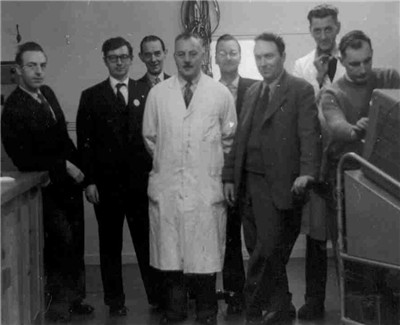
Frogmore Hall (project unknown).
left to right:- John Weston, Reg Teesdale, Bill Pledger, Fred Fenner,
John Church, Dennis Brown, Harry Knight, Arthur Hoerr.
There were many other users of Frogmore Hall. The Training Department found it convenient, although it was necessary to take trainees to lunch in a pub in the village of Watton-at-Stone, which was time consuming and very expensive. Arthur Brewster did extensive tests of his perimeter security system (Method 5). On another occasion, STL needed to check the performance of a high-powered sonar amplifier which they had developed for the Admiralty, and hydrophones fed from this amplifier were immersed in the pond, to the surprise and detriment, no doubt, of the fish population.
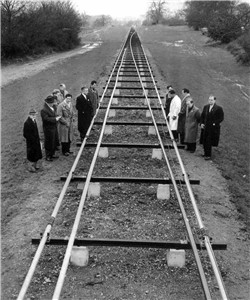 One of the most spectacular and demanding projects mounted at Frogmore Hall was the Long-Haul Waveguide test bed. The Long-Haul Waveguide consisted of a tube about three inches in diameter and had, in theory, an enormous transmission capacity, but it had one grave disadvantage. This was that the guide had to be dead straight. In order to test various types of tube, a test bed was set up at Frogmore Hall with concrete supports devised to support a third of a mile of waveguide without deviation from a straight line. Needless to say, this was a tricky mechanical problem, but Arthur Brewster came to the rescue of the contractors by devising an ingenious optical method of aligning the supports with great accuracy. It was quite an expensive job, but Arthur claims that, having been told that it was all in aid of a new system that would revolutionise telephone communications, the contractors reduced their charges. Tony Karbowiak and his staff did a lot of work on this test bed, but eventually the practical problems of installing waveguides in the ground and maintaining their straightness, together with the advent of optical fibres, led to the abandonment of the project.
One of the most spectacular and demanding projects mounted at Frogmore Hall was the Long-Haul Waveguide test bed. The Long-Haul Waveguide consisted of a tube about three inches in diameter and had, in theory, an enormous transmission capacity, but it had one grave disadvantage. This was that the guide had to be dead straight. In order to test various types of tube, a test bed was set up at Frogmore Hall with concrete supports devised to support a third of a mile of waveguide without deviation from a straight line. Needless to say, this was a tricky mechanical problem, but Arthur Brewster came to the rescue of the contractors by devising an ingenious optical method of aligning the supports with great accuracy. It was quite an expensive job, but Arthur claims that, having been told that it was all in aid of a new system that would revolutionise telephone communications, the contractors reduced their charges. Tony Karbowiak and his staff did a lot of work on this test bed, but eventually the practical problems of installing waveguides in the ground and maintaining their straightness, together with the advent of optical fibres, led to the abandonment of the project.
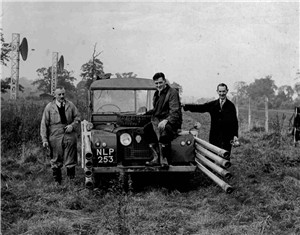 Eventually the Radio Survey Section was transferred to STC, but Frogmore Hall continued to be used. At one time the Harlow branch of the STC Patent Department, complete with Vi Maile, was installed there. It was also used as a document and equipment store.
Eventually the Radio Survey Section was transferred to STC, but Frogmore Hall continued to be used. At one time the Harlow branch of the STC Patent Department, complete with Vi Maile, was installed there. It was also used as a document and equipment store.
The original 21 year lease, taken out in 1956, ran out in 1977, and was extended for a further two years. So STL finally withdrew in 1979 after an occupation of 23 years. The writer is well aware that most of what has been described in this chapter took place during the first ten years of this period, and apologises to readers who may quite justifiably feel that some really interesting incidents have not been recorded.
Perhaps Frogmore Hall deserves a book to itself.
Postscript to Ken Pearson’s reminiscences
Clifford Want wrote:
Frogmore Hall also served for a number of years as the archive store for the STL Library and Information Service, and many a day was spent with library staff weeding the stock and moving boxes of journals from one shelf to another to make room for incoming archived stock. There was also a “storeman” who would retrieve stock from the archive for return to Harlow on demand.
Martin Iles wrote:
The article regarding Frogmore Hall brings back some memories!.
Being friends, we used visit Ian Turner and his family at weekends and holidays in the mid 60’s to 70’s, as kids my brother and I would often sleep in a green caravan kept next to the barn, or in the old gun-room. I remember the dozens of empty rooms on the upper floors and a walk up a stairwell would take you to the tower roof (ex-chapel) which had the words ‘EDWINA’S MAD HOUSE’ written in yellow paint across the asphalt.
The rabbit-blasting shotgun previously mentioned belonged to Ian Turner and was a single-barrelled Winchester Cooey 12-bore which is now in my possession (legally), he also owned a folding .410 but I don’t know what happened to that, I definitely saw a fur coat being pieced together out of rabbit-skins, and several stews being made.
Sadly, Ian was killed in a cycling accident some years later.
Yours sincerely, Martin Iles